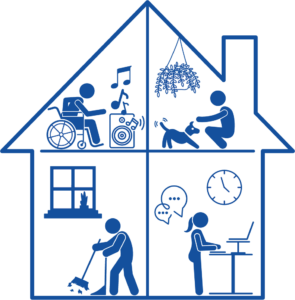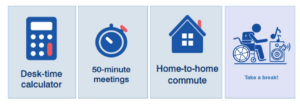This blog provides a toolkit developed based on ongoing research from the University of Edinburgh exploring ways to help those working from home move more during their day.

Shifting to working (too) comfortably
Cast your mind back to early 2020 – the world went into a global lockdown to control the spread of Covid-19. We were told; ‘if you can work from home – you should work from home’. And this led to many of us retreating to our home offices, or perhaps you were perched at the kitchen table, maybe you found yourself on the sofa. Bring yourself back to the present day, and many of us are still spending some of the working week at home [1]. Working at home has brought positives to our lives – more attainable work-life balance, reduced stress and cost of the rush-hour commute, you might even have time to cook all your meals from scratch! Unfortunately, there are also some negatives.
An October 2022 review showed sedentary behaviour increased by 16% (globally) because of Covid-19 and working at home [2]. For most people increased sedentary time will accumulate through spending prolonged periods at their desk (e.g., on email, MS Teams meetings, word processing). Unfortunately, elevated sedentary behaviour is an occupational health hazard with strong evidence that higher levels are unfavourably associated with cognitive function, depression, physical function, disability, and physical health QoL in adults [3]. Given that working at home looks set to continue for the longer term, it is imperative that solutions are developed to support those who work at home to do so in safe and healthy ways. Our research is focused on understanding how working at home increases sedentary behaviour, and how to best support employees to move more for their health and well-being.

Collaborating to move more
We started our research in January 2021, exploring staff perspectives of working at home and how their sedentary behaviour had changed. We then undertook a rapid review of existing evidence to identify interventions effective in office settings, and with input from workplace wellbeing stakeholders, appraised if they were transferable to the work at home setting [4]. Our review informed focus groups with: 1) employees, aged 18-40, currently working at home, and 2) line managers, to understand influences on sedentary behaviour while working at home, and ideas to support employees to reduce their sedentary behaviour. Findings were reviewed, and solutions refined at a workshop with the same participants. Informed by our research and behaviour change theory, we created a ‘toolkit’ to support behaviour change.
A toolkit for moving your way, during the working at home day
Based on our research participants’ suggestions to provide information in a ‘bite-sized’ format, we have set the toolkit up as a four-week programme, with different themes each week. It is also possible to ‘dip into’ the suggestions based on what suits you, and what works with your work at home routine. Over time, you’ll likely find those suggestions that work best for you, and that you enjoy the most –hopefully they will become a regular part of your work at home day. Suggestions include:
- Move more meetings: setting up meetings to be 50-minutes, rather than the default one hour setting, and using that time between appointments to move – rather than replying to emails;
- Active breaks: scheduling active breaks – which might be a short bout of physical activity, something like, squats or kettle-cises or some household chore, such as watering the plants or doing laundry;
- Active commute: making time for a ‘home-to-home’ commute before and/or after your working at home day.
- Tech: using technology to set reminders to move.

Making the toolkit work for you
Getting into new habits and changing behaviour can be difficult – especially to get started with. When working at home, we know that the day can become filled with back-to-back online meetings, you can become engrossed in a task, perhaps you lose track of time and before you know it you haven’t moved from the laptop for a couple of hours – you might even find your working day gets a little bit longer. Our toolkit has a range of suggestions that we hope you will find helpful in getting started.
- Form the intention: Firstly, it is important to make a decision that change is needed, and form an intention that you are going to reduce sedentary time.
- Make plans: Good intentions don’t always lead to action, so it can be helpful to carefully plan how you are going to move more. For example, on Monday morning look and see where you could schedule a no-screen moving meeting. Use a post-it to write down your plan (be specific – what, when and who with). Put the post-it somewhere you will see it to remind you, and also think of other ways to ‘prompt’ you (set a timer / alert on laptop or phone or smartwatch).
- Get support: It can also be really helpful to get others involved to help support you in changing behaviour – why not link up with a colleague, family member or friend and support each other to move more when you are working at home.
You can access our toolkit on the Actify platform [5].
Working at home is here to stay, so let’s make the most of it
Working at home looks set to be a long-term way of working – many of us enjoy working at home, and there are lots of positives that can be gained from being able to spend some of our week at home. However, it is imperative that early action is taken to mitigate risks that might come with this new way of working, and specifically those associated with prolonged sedentary behaviour. For those of us working at home, we’re most likely to be accumulating sedentary times while working at our desks. So to reduce the risks, one measure we can take is to move away from the desk and engage in some movement – be it for a few minutes or more. We hope that you find our toolkit a useful way of supporting you to engage in increased movement across your working at home day – get in touch to let us know what you thought of our toolkit.
Author information
Sarah Morton, Claire Fitzsimons, Divya Sivaramakrishnan, & Ailsa Niven
Physical Activity for Health Research Centre (PAHRC), University of Edinburgh
Author twitter handles: @_sarah_morton @CFFitzsimons @DivyaSivaramak @AilsaNiven
References
[1] https://www.economicsobservatory.com/working-from-home-what-can-we-learn-from-the-latest-uk-data
[2] Sedentary behaviour and health in adults: an overview of systematic reviews – PubMed (nih.gov)
[3] https://pubmed.ncbi.nlm.nih.gov/30352864/
[5] Actify